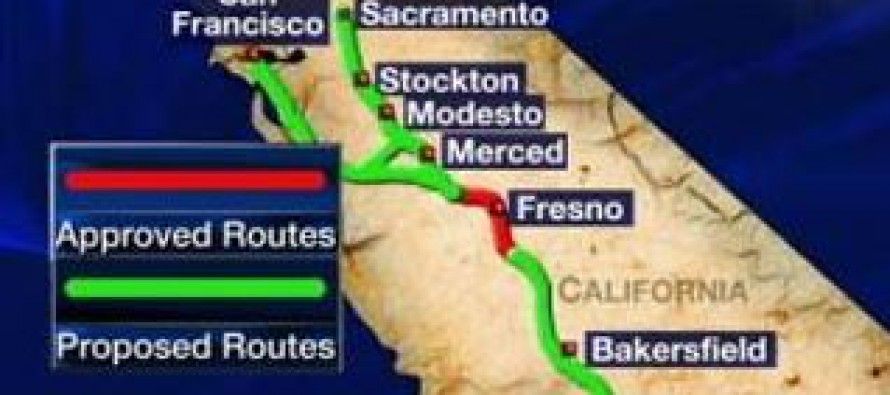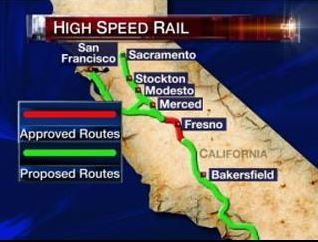State’s Bay Bridge follies will have bullet train encore

 When the first stories came out about the problems with the $6.5 billion San Francisco-Oakland Bay Bridge construction project, there was a faintly surprised tone to some of the coverage. They can’t get stuff like welds right? Really? But I was unsurprised. It was completely in keeping with the engineering genius on display with the bullet train. Now the Sac Bee has more:
When the first stories came out about the problems with the $6.5 billion San Francisco-Oakland Bay Bridge construction project, there was a faintly surprised tone to some of the coverage. They can’t get stuff like welds right? Really? But I was unsurprised. It was completely in keeping with the engineering genius on display with the bullet train. Now the Sac Bee has more:
“The Chinese company hired to build key parts of the San Francisco-Oakland Bay Bridge had never built a bridge.
“Shanghai Zhenhua Port Machinery Co. Ltd., after all, was a manufacturer of giant cranes for container ports.
“The California Department of Transportation agreed to contract the company known as ZPMC in 2006 because it had established a reputation as fast and cost-effective, offering savings of about $250 million compared to the competing bidder.
“Bridge officials were racing to finish the span, pushed years behind schedule and billions of dollars over budget by political squabbles and construction delays. Fearful that the old bridge might not survive a major quake, they wanted speed and savings.”
State wanted ‘speed and savings’ — sound familiar?
 Speed and savings — that’s been the watchword at the California High-Speed Rail Authority ever since three years ago, when Gov. Jerry Brown deemed $98 billion too high a pricetag for the project and pushed as hard as possible for groundbreaking, in ways that Judge Michael Kenny found against state law. The cost shrank to $68 billion because the gov gave up on true high-speed rail for a “blended” plan linking the southern edge of the San Francisco-San Jose metro area with the northern tip of the L.A. metro area. But there was also attempts to hide nearly $1 billion in costs — revealed a month ago — and a still-stunning analysis by Ralph Vartabedian in the Nov. 13, 2012, L.A. Times outlining the amazing complexity of what the state wanted to do:
Speed and savings — that’s been the watchword at the California High-Speed Rail Authority ever since three years ago, when Gov. Jerry Brown deemed $98 billion too high a pricetag for the project and pushed as hard as possible for groundbreaking, in ways that Judge Michael Kenny found against state law. The cost shrank to $68 billion because the gov gave up on true high-speed rail for a “blended” plan linking the southern edge of the San Francisco-San Jose metro area with the northern tip of the L.A. metro area. But there was also attempts to hide nearly $1 billion in costs — revealed a month ago — and a still-stunning analysis by Ralph Vartabedian in the Nov. 13, 2012, L.A. Times outlining the amazing complexity of what the state wanted to do:
“The sheer scale and scope of the bullet train’s push into Southern California, including traversing complex seismic hazards, would rival construction of the state’s massive freeway system, water transport networks and its port complexes. It is likely to be viewed in future decades as an engineering marvel — or a costly folly. …
“The plan calls for bullet trains to shoot east from Bakersfield at 220 mph, climbing one of the steepest sustained high-speed rail inclines in the world. It would soar over canyons on viaducts as high as a 33-story skyscraper. The line would duck in and out of tunnels up to 500 feet below the rugged surface. It would cross more than half a dozen earthquake faults heading toward L.A.
“Tunneling machines as long as a football field will have to be jockeyed into mountain canyons to do the heavy, back-breaking work once left to Chinese laborers. New access roads and a corridor for high-voltage power lines will have to be carved through the Tehachapis to feed power-hungry trains. When completed and fully operational, the bullet train will need an estimated 2.7 million kilowatt hours of electricity each day — about a quarter of Hoover Dam’s average daily output. …
“One measure of the topographic challenge: Over that 141 miles from Bakersfield to Los Angeles, up to 59% of the track would run in tunnels or on viaducts, according to preliminary planning documents. …”
$7.7 billion is the price tag? That’s all? Really?
More from Vartabedian:
“At this point, the rail authority estimates it will cost about $7.7 billion to build the 83 miles of rail from Bakersfield to Palmdale and about $12.5 billion to build the 58 miles of rail from Palmdale to Union Station. …
“Depending on the slope of the track, the tallest viaduct could be 200 to 330 feet off the ground.
“The same holds true for the segment through the San Gabriel Mountains, roughly following California 14. …
“California’s bullet train will have to operate over some of the nation’s most seismically active terrain … . There are half a dozen faults between Bakersfield and Los Angeles, including the White Wolf and San Andreas, both capable of producing a 7.5 magnitude quake. Where high viaducts are near faults, engineers are considering reinforced concrete structures that would resist ground motion and have containment features to prevent a derailed bullet train from plunging to the ground … . At full speed, however, a bullet train would need four to five miles to make an emergency stop on level ground, and longer going downhill.”
To repeat what I wrote last time, I don’t know how anyone could read this without thinking about every other sentence, “The state of California is competent to pull this off?” The preposterousness of the idea that the state government can build this while meeting the budget was apparent in 2012. The pattern of problems with far more minor challenges posed by the San Francisco-Oakland Bay Bridge project makes the bullet train building plan for the Tehachapis look not just preposterous but, well, insane.
Related Articles
Newsom reluctant to debate Nehring
Lt. Gov. Gavin Newsom is crusing to re-election victory on Gov. Jerry Brown’s coattails and the general strength of the
Tax Increase Vote in November?
John Seiler: The latest plot twist in the soap opera “As the Tax Increase Turns” could be putting Gov. Jerry
De Leon ‘green jobs’ vow didn’t pan out for Obama, Brown
New Senate President Kevin De Leon’s announcement Friday that creating a broad swath of “green jobs” would be a priority




